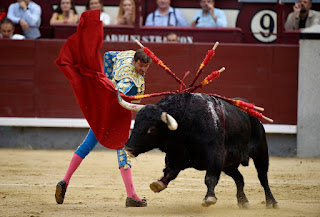
Bullfighting is a traditional cultural event, and some consider it to be an art form, in which a bull or bulls is fought in a ring by a bullfighter. It is not technically considered a sport, despite being referred to as such by some, because there are no elements of competition between people. The bullfighter is referred to as a torero, and the person who kills the bull is referred to as a matador (the most senior bullfighter). Bullfighting is most popular in Spanish-speaking countries such as Spain, Mexico, Peru, Ecuador, Columbia, Venezuela, and Portugal, but it is also practiced in some parts of southern France. The Plaza Mexico in Mexico City is the world’s largest bullfighting venue, while the oldest is in Seville, Spain, dating back to the late 1700s.
A bullfight, or ‘corrida,’ is divided into three stages, or ‘tercios.’ Each one is heralded by the sound of a trumpet.
A parade known as a ‘paseillo’ takes place prior to the first stage of a corrida. This parade consists of bullfight participants entering the arena and saluting whichever dignitary is presiding over the bullfight.
The Tercio de Varas is the first stage of a bullfight (third of lances). During this stage, the bull enters the ring and is tested, allowing the matador to observe how it charges and how fierce it is. When the bull charges, two picadors ride into the ring on horses and stab it in the neck. This causes the bull to lower its head, making it less dangerous to the matador.
The Tercio de banderillas is the second stage of a bullfight (third of flags). During this stage, three banderilleros attempt to insert two banderillas (sharp sticks) into the bull’s shoulders, which makes the bull angrier but also weaker.
The third stage of a bullfight is known as the Tercio de Muerte (third of death). During this stage, the matador enters the ring once more, this time carrying a sword and a red cape draped over a wooden rod. The matador makes a series of passes before killing the bull with a sword thrust between its shoulder blades and into its heart.
The matador has only 15 minutes to kill the bull, beginning with the first pass.
When a bull performs so well that the audience waves their handkerchiefs before the kill, the dignitary presiding over the bullfight has the authority to pardon the bull. It cannot be used in another bullfight after being pardoned because it is too dangerous. The matador is entrusted with the great honor of releasing the bull.
Many toreros or matadors have been gored by the bull because bullfighting is a dangerous sport.
Bullfighting has become illegal in some countries due to its violent nature. Many animal rights organizations are fighting to put an end to bullfighting because the bulls and horses used in the events are tortured.
The number of bullfights held around the world is decreasing year after year due to public opposition.









